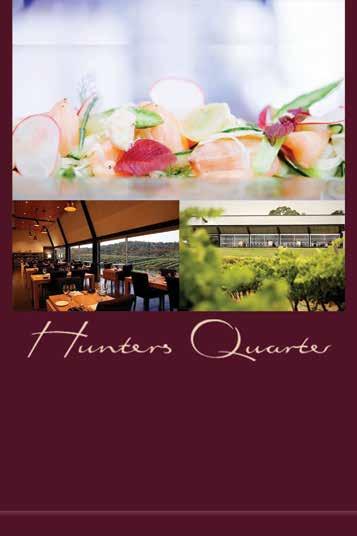
5 minute read
On the Wine History Trail
WINE HISTORY Trail! On the
WORDS Michelle Meehan
There probably aren’t many people who know more about the development of the Hunter Valley wine industry than the University of Newcastle’s senior lecturer in history, Julie McIntyre. The wine historian and co-author of the fascinating book, Hunter Wine: A History, took time out from her busy 2019 Fulbright Scholar program at the University of California to answer a few questions for this month’s Your Hunter Valley Magazine.
Where does your interest in history stem from, and how did you become a wine historian?
My interest in history began in high school, learning about the Australian past, and how approaches to Australian history have evolved over time. I started researching the emergence of winegrowing in New South Wales for my Bachelor of Arts (Honours) at the University of Newcastle, completed in 2002, followed by my PhD in Australian History at the University of Sydney, completed in 2009. Winegrowing provides such a fascinating lens onto Australia’s settler origins, culture, business, science and environments. This is in no small part because "No-one has attempted to write the sort of history we wrote about the Hunter on any other wine region in the world, recognising the distinctive historical as well as cultural qualities of the place and its people."
wine is such a beguiling product, but also because of the many different threads of history that are bound together in wine studies: Aboriginalsettler relations, immigration, business innovation and the formation of wine regions as cultural landscapes.
Where (and with whom) does your book, Hunter Wine: A History, begin, and where does it end? Hunter Wine: A History (NewSouth 2018) makes mention of the deep geological history of the region. This sets the scene for the frontier wars between Aboriginal people and settlers that occurred in the Hunter in the 1820's.
The book is then mostly concerned with providing a context for settler plantings of vines from the 1820's and six generations of winegrowers – across many families and locations – through to 1983. It is for future historians to write about the seventh and eighth generations of the region’s winegrowers since 1983.
How long did it take to research the book, and what did you and your co-author hope to achieve?
The book grew from connections with Hunter winegrowers that I would trace to 2011. In 2014, John Germov and I began formally working on the project that resulted in the book Hunter Wine and an exhibition at Newcastle Museum called Vines, Wine & Identity (August 2018–January 2019). As the whole project, by the Australian Research Council as well as the Hunter Valley Wine & Tourism Association and Newcastle Museum, John and I hoped to answer some really big questions: why did winegrowing continue in the Hunter over the timeframe that it did when other regions don’t have similar histories of continuity? How did Hunter wine shape Australian’s taste for wine? And, I kept asking myself as I worked on the project, how would I explain what was lost if the Hunter stopped producing wine?
No-one has attempted to write the sort of history we wrote about the Hunter on any other wine region in the world, recognising the distinctive historical as well as cultural qualities of the place and its people. We are very proud that the book has been recognised by both Australian historians, as a finalist in the NSW Premier’s History Awards, and the (Continued next page) ⊲


(Continued)
international wine industry for its contribution to wine history, with the Special Mention for History at the OIV Jury Awards of 2019, as well as Best Wine Book at the Wine Communicators of Australia 2018 Awards.
I think a lot of people have a general idea of the Hunter's wine history - but what was the most interesting/surprising thing you discovered while writing your book?
I found it fascinating to learn that the Hunter has been a quality wine region for most of its history, compared with many other Australian wine regions, because its environment will not support largescale production. The region’s reputation was very strong at the turn of the twentieth century before the temperance era in Australia from the late 1910's to the 1950's changed drinking culture; suppressing the
NO.1 SHORT STAY HOLIDAY & PROPERTY MANAGEMENT GROUP

Escape the everyday and unlock the doors to our collection of more than 80 hand-picked properties. Close to your favourite cellar doors, wineries, breweries, restaurants, wedding and concert venues and perfect for large groups of family and friends, corporate escapes, couples retreats, wedding guests or your milestone celebrations.
BOOK DIRECT WITH US FOR THE BEST AVAILABLE ACCOMMODATION RATES
convivial style of wine drinking that had begun to flourish up to the outbreak of World War 1.
I really enjoyed reading the findings of the 1954 Inquiry into NSW licencing that cleared the way to reinstate regulations conducive to “civilised drinking” of wine and other alcohols.
I loved weaving together histories of wine industry workers as well as vineyard owners. The chapter on Germans in the Hunter wine story required an enormous amount of research to bring to life people who have up, until now, been explained only in terms of their Anglicised names and places of origin, and the ships they arrived on.
The strength of family and social networks among winegrowers is also astonishing. Of course, people within a regional community of producers have their differences, but Hunter winegrowers have always found common ground when it’s been a matter of survival for longevity. ■
WE BELIEVE IN THE SIMPLE THINGS IN LIFE. THEY JUST NEED TO BE AMAZING.
SMART CASUAL DINING FRESH LOCAL PRODUCE ALSO WEDDINGS | EVENTS | PRIVATE FUNCTIONS

LOCATED ON THE VINE AT COCKFIGHTERS GHOST VINEYARD 576 DE BEYERS ROAD, POKOLBIN PH: 4998 7776 | info@huntersquarter.com.au www.huntersquarter.com.au










